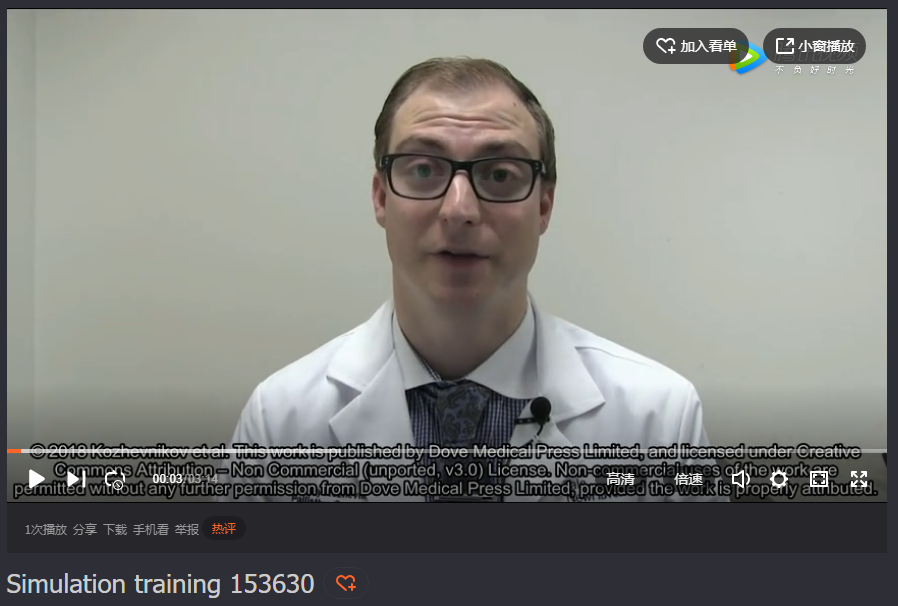9 0 6 7 6
论文已发表
注册即可获取德孚的最新动态
IF 收录期刊
- 2.6 Breast Cancer (Dove Med Press)
- 3.9 Clin Epidemiol
- 3.3 Cancer Manag Res
- 3.9 Infect Drug Resist
- 3.6 Clin Interv Aging
- 4.8 Drug Des Dev Ther
- 2.8 Int J Chronic Obstr
- 8.0 Int J Nanomed
- 2.3 Int J Women's Health
- 3.2 Neuropsych Dis Treat
- 4.0 OncoTargets Ther
- 2.2 Patient Prefer Adher
- 2.8 Ther Clin Risk Manag
- 2.7 J Pain Res
- 3.3 Diabet Metab Synd Ob
- 4.3 Psychol Res Behav Ma
- 3.4 Nat Sci Sleep
- 1.9 Pharmgenomics Pers Med
- 3.5 Risk Manag Healthc Policy
- 4.5 J Inflamm Res
- 2.3 Int J Gen Med
- 4.1 J Hepatocell Carcinoma
- 3.2 J Asthma Allergy
- 2.3 Clin Cosmet Investig Dermatol
- 3.3 J Multidiscip Healthc

Simulation training in palliative care: state of the art and future directions
Authors Kozhevnikov D, Morrison LJ, Ellman MS
Received 1 August 2018
Accepted for publication 26 October 2018
Published 7 December 2018 Volume 2018:9 Pages 915—924
DOI https://doi.org/10.2147/AMEP.S153630
Checked for plagiarism Yes
Review by Single-blind
Peer reviewers approved by Dr Colin Mak
Peer reviewer comments 3
Editor who approved publication: Dr Anwarul Azim Majumder
Background: The growing
need for palliative care (PC) among patients with serious illness is
outstripped by the short supply of PC specialists. This mismatch calls for
competency of all health care providers in primary PC, including
patient-centered communication, management of pain and other symptoms, and
interprofessional teamwork. Simulation-based medical education (SBME) has
emerged as a promising modality to teach key skills and close the educational
gap. This paper describes the current state of SBME in training of PC skills.
Methods: We
conducted a systematic review of the literature reporting on simulation experiences
addressing PC skills for clinical learners in medicine and nursing. We
collected data on learner characteristics, the method and content of the
simulation, and outcome assessments.
Results: In
a total of 78 studies, 76% involved learners from medicine and 38% involved
learners from nursing, while social work (6%) and spiritual care (3%) learners
were significantly underrepresented. Only 16% of studies involved collaboration
between participants at different training levels. The standardized patient
encounter was the most popular simulation method, accounting for 68% of all
studies. Eliciting treatment preferences (50%), delivering bad news (41%), and
providing empathic communication (40%) were the most commonly addressed skills,
while symptom management was only addressed in 13% of studies. The most common
method of simulation evaluation was subjective participant feedback (62%). Only
4% of studies examined patient outcomes. In 22% of studies, simulation outcomes
were not measured at all.
Discussion: We
describe the current state of SBME in PC education, highlighting advances over
recent decades and identifying gaps and opportunities for future directions. We
recommend designing SBME for a broader range of learners and for
interprofessional skill building. We advocate for expansion of skill content,
especially symptom management education. Finally, evaluation of SBME in PC
training should be more rigorous with a shift to include more patient outcomes.
Keywords: simulation
training, palliative care, palliative medicine, standardized patient,
structured clinical examination, medical education
摘要视频链接:Simulation
training in palliative care
